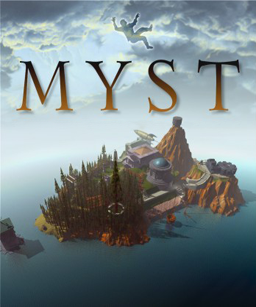
Myst is a graphic adventure puzzle video game designed by the Miller brothers, Robyn and Rand. It was developed by Cyan, Inc., published by Broderbund, and initially released for the Macintosh personal computer platform in 1993. In the game, players travel via a special book to the island of Myst. There, players solve puzzles, and by doing so, travel to four other worlds, known as Ages, which reveal the backstory of the game's characters.

Riven is a puzzle adventure video game. It is the sequel to Myst and second in the Myst series of games. Developed by Cyan Worlds, it was initially published by Red Orb Entertainment, a division of Broderbund. Riven was distributed on five compact discs and released on October 31, 1997, in North America; it was later released on a single DVD-ROM on August 17, 1998, with improved audio and a fourteen-minute "making-of" video. In addition to the PC versions, Riven has been ported to several other platforms.

Pathways into Darkness is a first-person shooter action-adventure video game developed and published by Bungie in 1993, for Apple Macintosh personal computers. Players assume the role of a Special Forces soldier who must stop a powerful, godlike being from awakening and destroying the world. Players solve puzzles and defeat enemies to unlock parts of a pyramid where the god sleeps; the game's ending changes depending on player actions.

Uru: Ages Beyond Myst is an adventure video game developed by Cyan Worlds and published by Ubisoft. Released in 2003, the title is the fourth game in the Myst canon. Departing from previous games of the franchise, Uru takes place in the modern era and allows players to customize their onscreen avatars. Players use their avatars to explore the abandoned city of an ancient race known as the D'ni, uncover story clues and solve puzzles.

Myst IV: Revelation is an adventure video game, the fourth installment in the Myst series, developed and published by Ubisoft. Like Myst III: Exile, Revelation combines pre-rendered graphics with digital video, but also features real-time 3D effects for added realism. The plot of Revelation follows up on plot details from the original Myst. The player is summoned by Atrus, a man who creates links to other worlds known as Ages by writing special linking books. Almost twenty years earlier, Atrus' two sons nearly destroyed all of his books and were imprisoned; Atrus now wishes to see if his sons' imprisonment has reformed them. The player travels to each brother's prison, in an attempt to recover Atrus' daughter Yeesha from the brothers' plot.
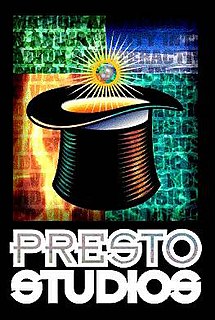
Presto Studios was a computer game development company of the 1990s, especially famous for its award-winning The Journeyman Project series and the 2001 sequel to Cyan's hit Myst series, Myst III: Exile.
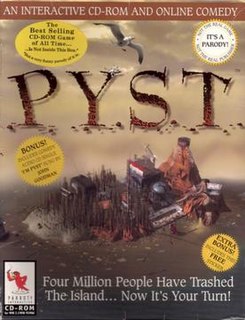
Pyst is an adventure computer game released in October 1996. It was created as a parody of the highly successful adventure game Myst. Pyst was written by Peter Bergman, a co-founder of the Firesign Theatre, and was published by Parroty Interactive, with Bergman, Stallone, Inc. as co-publisher. Mindscape began distributing the game on August 20, 1997. The parody features full motion video of actor John Goodman as "King Mattruss", the ruler of "Pyst Island". Versions of the game were produced for both the Windows PC and Apple Macintosh operating systems.
Myst is a franchise centered on a series of adventure video games. The first game in the series, Myst, was released in 1993 by brothers Rand and Robyn Miller and their video game company Cyan, Inc. The first sequel to Myst, Riven, was released in 1997 and was followed by three more direct sequels: Myst III: Exile in 2001, Myst IV: Revelation in 2004, and Myst V: End of Ages in 2005. A spinoff featuring a multiplayer component, Uru: Ages Beyond Myst, was released in 2003 and followed by two expansion packs.

Myst V: End of Ages is a 2005 adventure video game, the fifth installment in the Myst series. The game was developed by Cyan Worlds, published by Ubisoft, and released for Macintosh and Windows PC platforms in September 2005. As in previous games in the series, End of Ages's gameplay consists of navigating worlds known as "Ages" via the use of special books and items which act as portals.
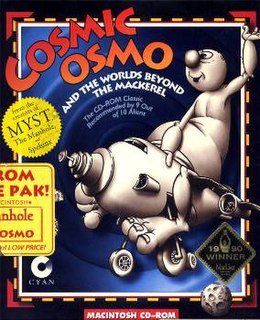
Cosmic Osmo and the Worlds Beyond the Mackerel is a graphic adventure computer game for the Macintosh computer line created by Cyan, Inc. It was published in 1989 and won the 1990 Mac User's Editors' Choice Award for the "Best Recreational Program" category.
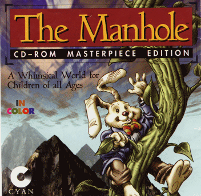
The Manhole is an adventure video game in which the player opens a manhole and reveals a gigantic beanstalk, leading to fantastic worlds.

Moonmist is an interactive fiction computer game written by Stu Galley and Jim Lawrence and published by Infocom in 1986. The game was released simultaneously for the Amiga, Amstrad CPC, Apple II, Atari 8-bit family, Atari ST, Commodore 64, MS-DOS, TRS-80, TI-99/4A, and Macintosh. It is Infocom's twenty-second game. Moonmist was re-released in Infocom's 1995 compilation The Mystery Collection, as well as the 1996 compilation Classic Text Adventure Masterpieces.
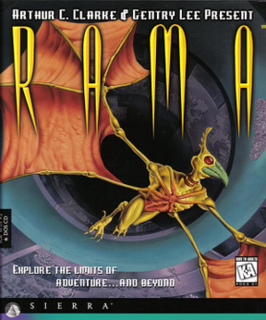
Rama is a first-person adventure game developed and published by Sierra On-Line in 1996. The game is based on Arthur C. Clarke's books Rendezvous with Rama (1973) and Rama II (1989) and supports both MS-DOS and Windows. In 1998, a PlayStation version was released in Japan.

Obsidian is a 1997 graphic adventure game developed by Rocket Science Games and published by SegaSoft. It was released for Microsoft Windows and Mac OS.

Qin: Tomb of the Middle Kingdom is a Myst-like graphic adventure computer game developed by Learn Technologies Interactive published by Time Warner Interactive and released for Windows and Macintosh systems.

Timelapse is a 1996 graphic adventure game developed and published by GTE Entertainment. Inspired by the game Myst, it tasks the player with the rescue of an archaeologist trapped in another dimension. The player navigates a series of time portals to locations such as ancient Egypt, Maya and the prehistoric Puebloan civilization, while solving puzzles and searching for clues to the archaeologist's whereabouts.

The Dame Was Loaded is a first-person point-and-click adventure game for MS-DOS and Macintosh created by Australian developer Beam Software. It was published in 1996 by Philips Interactive Media.

The Myst series of adventure computer games deals with the events following the player's discovery of a mysterious book describing an island known as Myst. The book is no ordinary volume; it is a linking book, which serves as a portal to the world it describes. The player is transported to Myst Island and must unravel the world's puzzles in order to return home. Myst was a commercial and critical success upon release and spawned four sequels—Riven, Exile, Revelation and End of Ages— as well as several spinoffs and adaptations.

Warcraft II: Tides of Darkness is a fantasy real-time strategy computer game developed by Blizzard Entertainment and released for DOS in 1995 and Mac OS in 1996 by Blizzard's parent, Davidson & Associates. A sequel to Warcraft: Orcs & Humans, the game was met with positive reviews and won most of the major PC gaming awards in 1996. In 1996, Blizzard released an expansion pack, Warcraft II: Beyond the Dark Portal, for DOS and Mac OS, and a compilation, Warcraft II: The Dark Saga, for the PlayStation and Sega Saturn. The Battle.net edition, released in 1999, included Warcraft II: Beyond the Dark Portal, provided Blizzard's online gaming service, and replaced the MS-DOS version with a Windows one.
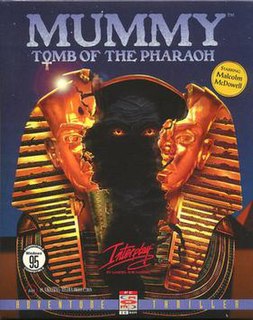
Mummy: Tomb of the Pharaoh is a point-and-click adventure video game released on August 31, 1996 by Interplay Productions on Windows and by MacPlay, a division of Interplay Productions at the time, on Macintosh. It is a sequel to Frankenstein: Through the Eyes of the Monster. The game was developed by Amazing Media, directed and produced by Jeff McDonald, Keith Metzger, and Loring Casartelli, written by McDonald and Metzger, and composed by Márcio Câmara. Malcolm McDowell stars as Stuart Davenport, one of the main characters of the game.



















